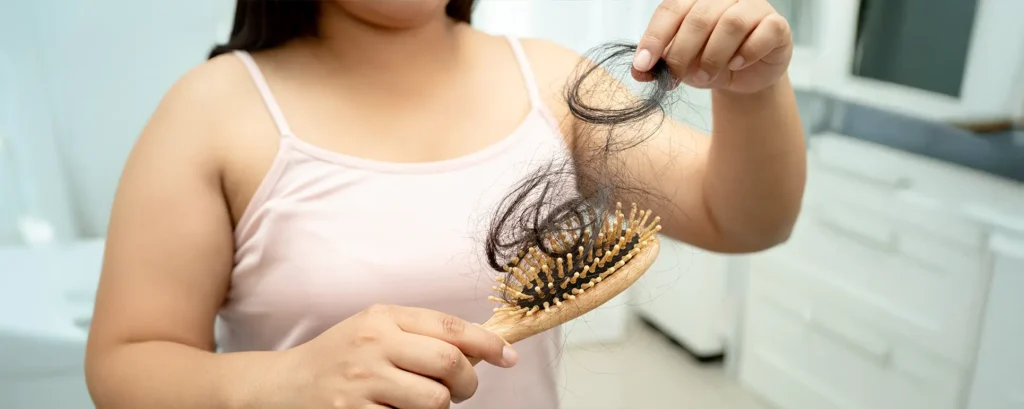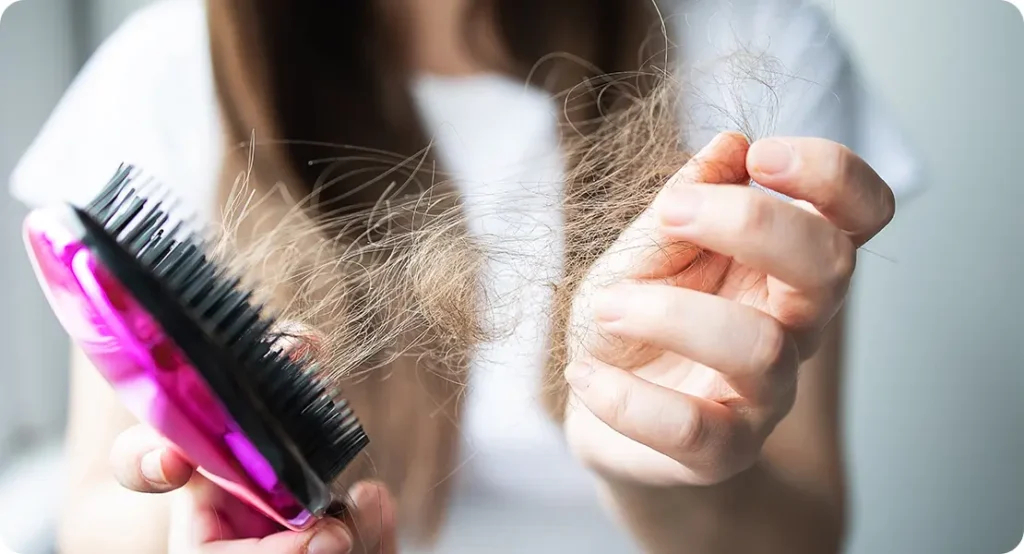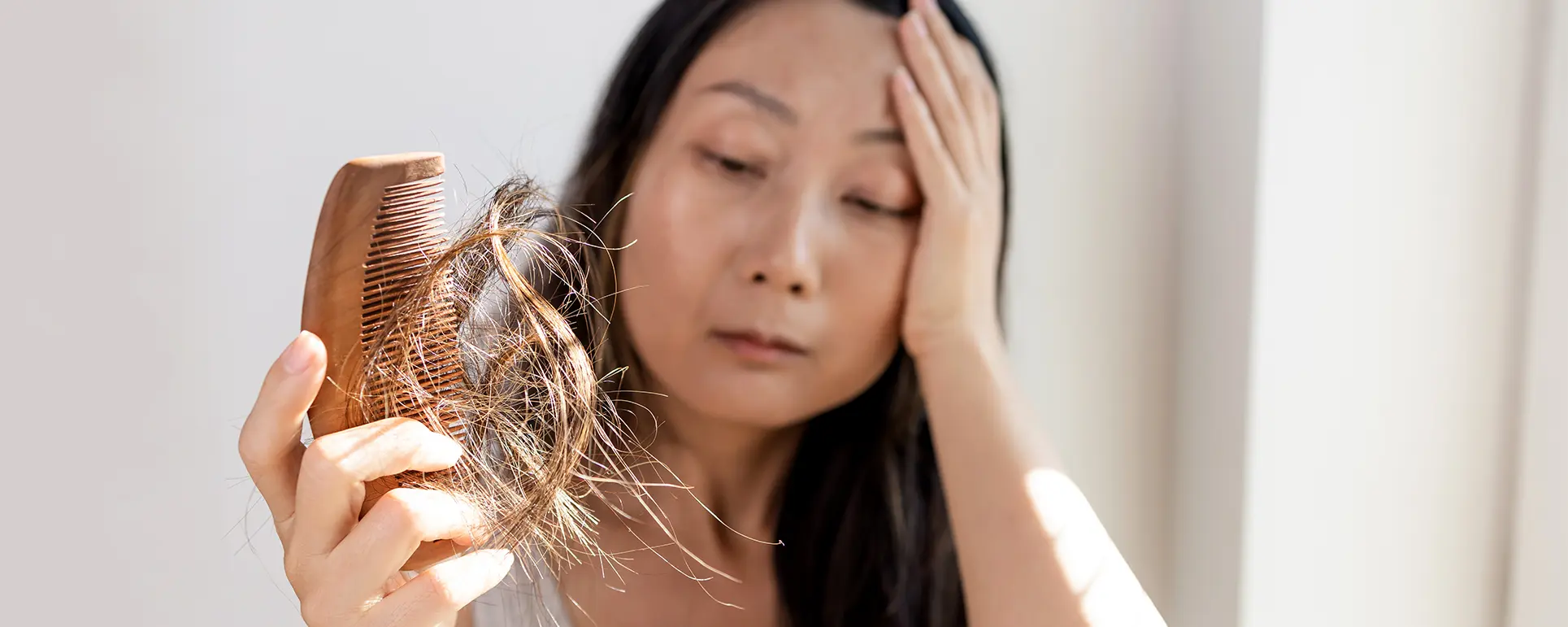If you’ve been noticing your hair thinning, shedding more than usual, or becoming patchy in certain areas, you may be dealing with female alopecia and I want you to know that you’re not alone. Hair loss in women is incredibly common, but it’s also massively misunderstood. Many women are told it’s “normal” or “part of ageing,” and others feel dismissed when they try to get help. That leaves countless women struggling in silence, feeling unsure whether the hair changes they see are temporary, treatable or something more serious.
The truth is that alopecia in women has many causes and almost all of them are manageable when you understand what’s happening. Hormones, genetics, stress, styling habits, illness, medication and nutrition all play a role. When you know the root of your thinning, you can choose the right treatment and finally stop feeling confused or frustrated.
In this guide, I want to walk you through the real causes of female alopecia, how to identify what type you might have, and the treatments that genuinely work. Whether your hair is thinning gradually or shedding suddenly, you deserve answers and options that help you feel like yourself again.
What Is Female Alopecia?
Female alopecia simply means hair loss or hair thinning in women, and it isn’t one single condition. It’s an umbrella term that covers various patterns and types of hair loss.
Common types include:
- Female pattern hair loss (FPHL)
- Telogen effluvium
- Alopecia areata
- Traction alopecia
- Scarring alopecia
- Hormone-related alopecia
Because each type behaves differently, recognising your symptoms is the first step in choosing the right treatment.
Why Female Alopecia Is Often Missed or Misdiagnosed

Women aren’t always taught what “normal” shedding looks like, and many early signs of alopecia are subtle. Instead of bald patches, women often notice:
- Wider parting
- Thinning around the crown
- Loss of volume on top
- More scalp visibility
- Shorter regrowth cycles
- Hair that feels finer than before
These gradual changes can be mistaken for normal ageing or stress but they’re often early warning signs.
The Most Common Causes of Female Alopecia
Let’s look at the triggers and conditions that most frequently lead to thinning in women.
1. Genetics: Female Pattern Hair Loss (FPHL)
Genetics are the number one cause of hair thinning in women. FPHL can start at any age, including your 20s or 30s, although it’s most common after 40.
Typical signs:
- Widening part line
- Reduced density on the crown
- Finer texture
- Slow thinning over years
Unlike male pattern baldness, women rarely lose the entire hairline, but density can drop significantly.
This form of alopecia is chronic but treatable and early intervention makes a huge difference.
2. Hormonal Changes & Perimenopause
Many women first notice thinning around perimenopause because oestrogen levels begin to drop. Oestrogen normally protects hair, so when it declines, hair becomes finer, weaker and more prone to shedding.
Other hormonal triggers include:
- Pregnancy
- Postpartum changes
- Stopping or starting contraception
- PCOS
- Thyroid disorders
If your hair loss flares during hormonal changes, stabilising your hormones can help.
3. Telogen Effluvium (Sudden Shedding)
If you’re shedding handfuls of hair suddenly often after illness, stress or a major life event telogen effluvium may be the cause.
Common triggers include:
- Viral infections
- COVID-19
- Surgery
- Crash dieting
- Severe stress
- Iron deficiency
- Medication changes
This type of alopecia is temporary, but you still need a plan to support regrowth and prevent long-term thinning.
4. Styling Damage & Traction Alopecia
Years of tight styling (braids, weaves, ponytails), frequent heat use or chemical treatments can slowly damage follicles.
Key signs:
- Thinning around the temples
- Broken hairs along the hairline
- Soreness or redness
- Gradual loss at tension points
If caught early, growth can return but long-term traction can cause permanent loss.
5. Autoimmune Alopecia (Alopecia Areata)
Alopecia areata is caused by the immune system mistakenly attacking hair follicles.
How it shows up:
- Round or coin-sized patches
- Sudden loss
- Eyebrow or lash thinning
- Repeating cycles of shedding and regrowth
This type requires medical treatment but often responds well to modern therapies.
6. Nutritional Deficiencies
Hair relies on proper nutrition, and even small deficiencies can trigger shedding.
Common deficiencies causing hair loss:
- Iron
- Vitamin D
- B12
- Zinc
- Biotin (rarer than people think)
- Protein deficiency
Low iron is one of the leading causes of female thinning worldwide.
7. Stress & Cortisol Imbalance
Chronic stress sends follicles into a resting phase, resulting in increased shedding.
If you’ve been through a highly stressful period, your hair may start falling out months later something many women don’t realise.
8. Medications That Trigger Hair Loss
Some medications list hair thinning as a side effect.
Common examples:
- Antidepressants
- Acne treatments
- Blood pressure medication
- Thyroid medication
- Hormone treatments
- Blood thinners
A dermatologist can help identify whether your medication is contributing.
9. Scalp Conditions
Inflammation on the scalp interrupts the hair growth cycle.
Conditions to look for:
- Seborrheic dermatitis
- Psoriasis
- Fungal infections
- Folliculitis
These often need targeted treatment to resolve shedding.
How to Tell What Type of Alopecia You Have

You can get clues by looking at:
1. The pattern of thinning
Is it the crown? Parting? Temples? Patches?
2. The speed of shedding
Sudden vs gradual?
3. Your recent life events
Stress? Illness? Pregnancy?
4. Your styling habits
Tight hairstyles? Chemical treatments?
5. The texture of new regrowth
Is it finer than before?
A dermatologist can confirm everything through:
- Scalp examination
- Trichoscopy
- Blood tests
- Pull tests
- Hormonal evaluation
It’s worth getting a proper diagnosis so you know which treatment will work best.
Dermatologist-Approved Treatments That Actually Help
Here’s what evidence shows actually improves hair growth in women.
1. Minoxidil
Minoxidil is one of the most effective, widely researched treatments for female pattern hair loss.
Benefits:
- Increases blood flow
- Prolongs hair’s growth phase
- Improves thickness
- Works for many types of alopecia
It comes as a foam or solution and can be used long-term.
2. Oral Medications
Women often respond well to medications that reduce hair miniaturisation.
Common options include:
- Spironolactone
- Dutasteride
- Finasteride (post-menopause)
- Cyproterone acetate (in specific cases)
These can be game-changing for hormonally active alopecia.
3. PRP (Platelet-Rich Plasma)
PRP is one of the most effective non-surgical treatments for female alopecia.
Benefits include:
- Stronger follicles
- Faster regrowth
- Reduced shedding
- Improved density
It works especially well for genetic and postpartum thinning.
4. Exosome or Growth Factor Therapy
These advanced regenerative treatments stimulate dormant follicles and improve scalp health.
They’re especially useful for women who want faster density improvements.
5. Low-Level Laser Therapy (LLLT)
Laser caps and clinical LED treatments help improve circulation and reduce inflammation two major factors in female alopecia.
6. Treating Nutritional Deficiencies
Correcting deficiencies is essential.
The most important tests include:
- Ferritin
- Vitamin D
- B12
- Thyroid panel
If your levels aren’t optimal, regrowth will be limited.
7. Anti-Inflammatory Scalp Treatments
Your dermatologist may recommend:
- Ketoconazole shampoo
- Salicylic acid
- Coal tar
- Steroid lotions
- Antifungal treatments
Reducing inflammation is crucial for long-term hair health.
8. Lifestyle Adjustments
You can boost regrowth by:
- Reducing stress
- Getting enough sleep
- Avoiding tight hairstyles
- Using gentle heat settings
- Maintaining a balanced diet
Small habits can make a huge difference.
How Long Does It Take for Treatments to Work?
Hair grows slowly, so patience is essential.
Typical timeline:
- 6–8 weeks: shedding slows
- 3 months: new growth begins
- 6 months: noticeable volume increase
- 12 months: full results
Consistency is the key to success.
FAQs:
1. What exactly is female alopecia, and how is it different from male hair loss?
Female alopecia refers to hair thinning or hair loss in women and is an umbrella term for several different types. Unlike male pattern baldness, which often results in a receding hairline or complete bald spots on the crown, women generally experience a diffuse thinning across the scalp. The hairline is usually preserved, but the density reduces over time. Women may notice that their parting appears wider, the crown looks less full, or hair feels finer and more fragile. Understanding these differences is crucial because it helps women and dermatologists identify the cause and choose the right treatment.
2. Can hair thinning in women be a normal part of ageing?
Yes, to some extent, gradual hair thinning can occur as part of the natural ageing process, especially after menopause when oestrogen levels decline. However, significant or sudden hair loss is usually not “just ageing” and should not be ignored. Many women mistake early signs of alopecia for normal ageing and delay seeking help, which can limit the effectiveness of treatments. Early assessment by a dermatologist can help distinguish between normal hair changes and treatable hair loss conditions.
3. How do hormones influence hair loss in women?
Hormones play a central role in hair health. Oestrogen helps maintain the hair growth cycle, so when levels drop during perimenopause or menopause, hair can become thinner and weaker. Pregnancy and postpartum changes, thyroid imbalances, polycystic ovary syndrome (PCOS), and contraceptive use can also trigger shedding. Hormonal fluctuations may cause temporary hair loss or worsen underlying pattern hair loss. Managing hormone levels through medical guidance can help stabilise hair growth and reduce shedding.
4. Why do some women suddenly shed a lot of hair?
Sudden hair shedding is often caused by telogen effluvium, a condition where a large number of hair follicles prematurely enter the resting phase. This can be triggered by major stressors such as illness, surgery, viral infections like COVID-19, nutritional deficiencies, crash dieting, or emotional stress. Shedding may appear several weeks to months after the triggering event. Although telogen effluvium is usually temporary, addressing the underlying cause and supporting regrowth is essential for long-term hair health.
5. How can styling habits cause hair loss?
Repeated mechanical stress from tight hairstyles, braids, ponytails, or hair extensions can damage follicles over time, leading to traction alopecia. Chemical treatments like bleaching, straightening, or frequent heat styling can further weaken hair and contribute to breakage. Women often notice thinning around the temples or along the hairline and may experience soreness or redness. Early recognition is key because if the damage is ongoing, it can become permanent, whereas gentle styling and scalp care can allow regrowth.
6. Can diet and nutrition really affect hair density?
Absolutely. Hair growth requires a balance of nutrients, and even small deficiencies can trigger shedding or slow regrowth. Iron deficiency is one of the most common contributors to female alopecia worldwide, and low levels of vitamin D, B12, zinc, and protein can also impact hair health. While biotin deficiency is rare, ensuring a diet that supports hair growth, or supplementing when necessary, can significantly improve results when combined with other treatments.
7. Are there effective medical treatments for female hair loss?
Yes, there are several dermatologist-approved treatments that have been shown to help. Minoxidil is one of the most widely researched options and can thicken hair and stimulate growth. Oral medications such as spironolactone or dutasteride may help reduce hormonal miniaturisation of follicles. Platelet-rich plasma (PRP) therapy, growth factor treatments, and low-level laser therapy can also support regrowth. Choosing the right approach depends on the type and severity of alopecia, and a personalised plan from a dermatologist often yields the best results.
8. How long does it take to see results from treatment?
Hair grows slowly, so patience is important. In most cases, shedding may slow after six to eight weeks, with new growth becoming noticeable at around three months. By six months, many women observe a visible improvement in volume and thickness, and full results can take up to twelve months. Consistency is crucial, as irregular use of treatments can limit effectiveness, and stopping treatment prematurely can cause hair loss to resume.
9. Can stress really cause hair loss, and can hair regrow afterwards?
Yes, chronic stress increases cortisol levels, which can push follicles into a resting phase and trigger shedding. This is often delayed, meaning women might notice hair loss months after a stressful period. The good news is that once the stressor is addressed, and with proper treatment and scalp care, hair usually regrows. Supporting hair with nutrition, reducing ongoing stress, and following medical guidance enhances recovery.
10. When should I see a dermatologist about hair thinning?
You should consider seeing a dermatologist as soon as you notice persistent changes, such as widening part lines, reduced density on the crown, sudden shedding, or patchy loss. Early diagnosis is key to choosing an effective treatment and preventing long-term thinning. A dermatologist can perform scalp examinations, blood tests, trichoscopy, and hormone assessments to determine the underlying cause and provide a personalised plan for regrowth and maintenance.
Final Thought: Getting the Right Care for Female Alopecia
Female alopecia can feel overwhelming, but understanding the causes and available treatments makes a huge difference. Whether your thinning is gradual, sudden, or patchy, early intervention gives the best chance of regrowth and improved density. Evidence-backed approaches from minoxidil and oral medications to PRP and lifestyle adjustments can help restore both hair and confidence. If you’re considering Alopecia treatment in London, contact us at London Dermatology Centre to book a consultation with one of our specialists and get a personalised plan tailored to your needs.
References:
1. Olsen, E.A. et al., 2019. Female pattern hair loss and androgen excess: a report from the Multidisciplinary Androgen Excess and PCOS Committee. The Journal of Clinical Endocrinology & Metabolism, 104(7), pp.2875–2889. https://academic.oup.com/jcem/article/104/7/2875/5342938
2. Aleissa, S., Alajlan, A., Aladwani, B. et al. (2023). The efficacy and safety of oral spironolactone in the treatment of female pattern hair loss: a systematic review and meta‑analysis. Journal of Dermatological Treatment, 54, pp. 411–415. https://pubmed.ncbi.nlm.nih.gov/37719557/
3. Herskovitz, I. & Tosti, A. (2018). Female pattern hair loss: a clinical, pathophysiologic, and therapeutic review. Journal of the American Academy of Dermatology, 78(3), pp. 481–492. https://pubmed.ncbi.nlm.nih.gov/30114864/
4. Seyed Jafari, S. M., Heidemeyer, K., Hunger, R. E. & de Viragh, P. A. (2024). Safety of Antiandrogens for the Treatment of Female Androgenetic Alopecia with Respect to Gynecologic Malignancies. Journal of Clinical Medicine, 13(11), 3052. https://www.mdpi.com/2077-0383/13/11/3052 5. Krefft‑Trzciniecka, K., Cisoń, H., Pakiet, A., Nowicka, D. & Szepietowski, J. C. (2024). Enhancing Quality of Life and Sexual Functioning in Female Androgenetic Alopecia: Therapeutic Potential of Hair Follicle‑Derived Stem Cells. Healthcare, 12(6), 608. https://www.mdpi.com/2227-9032/12/6/608
